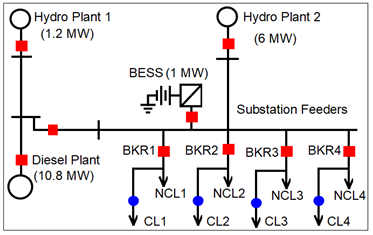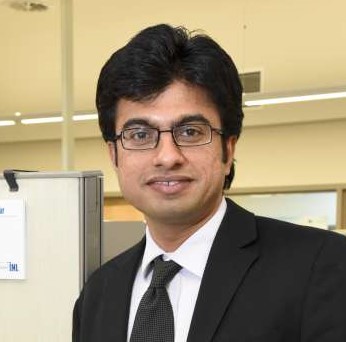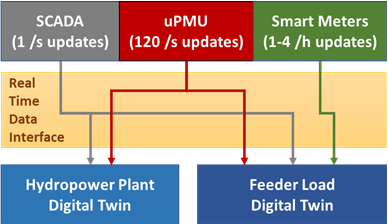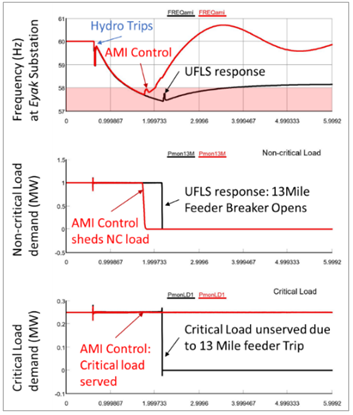Real-Time Digital Twin for an Alaskan Microgrid Using SCADA, Distribution PMUs, and Smart Meter Data
Written by Mayank Panwar1, Rob Hovsapian1, Manish Mohanpurkar1, and Clay Koplin2
1National Renewable Energy Laboratory, Boulder, CO, USA
2Cordova Electric Cooperative, Cordova, AK, USA
This article presents the digital twin development of an actual microgrid in Cordova, Alaska, in a real-time simulation environment using multi-resolution data from SCADA at one second resolution, distribution phasor measurement units (PMUs), and smart meter (approx. 2000 meters). The work is performed under the DOE Grid Modernization project titled Resilient Alaskan Distribution system Improvements using Automation, Network analysis, Control, and Energy storage (RADIANCE) for field validation of resilience enhancement technologies. The development process and setup are described, and some relevant use-cases for field validation are discussed.
Introduction
The microgrid in Cordova, Alaska is managed and operated by the Cordova Electric Cooperative (CEC) and consists of 7.5 MW hydropower, 10.8 MW diesel, and 1MW/1MWh battery energy storage system as shown in Figure 1. The microgrid is an islanded system with no transmission-level interconnection. It maintains stability and resilience against dynamic and seasonal loading (fish canneries), glacial melt hydro, harsh weather conditions, and natural events such as avalanche, tsunami, and so on.
Figure 1: A 20 MW microgrid in Cordova, AK where distribution PMUs and smart meter are being deployed for resileince enhancement as part of DOE’s Grid Modernization RADIANCE project (left); Digital twin schematic with locations highlighted where distribution PMUs are installed (right).
The digital twin serves multi-fold objectives to support regional field validation in the RADIANCE project [1].
- Rapid prototyping and hardware-in-the-loop (HIL)-based validation of resilience enhancement methods for distribution grids under harsh weather, cyber-threats, and dynamic grid conditions.
- Minimize the risk of field deployment and sub-system integration for coordinated operation of battery energy storage, hydro, diesel, and early-stage grid technologies such as distribution PMUs (also called micro-PMUs) and smart meters for load management.
- Validate and instantiate digital twin using field data for iterative HIL testing based on results from partial field deployment and provide insights into practical use of resilience metrics.
Real-Time Digital Twin
CEC microgrid digital twin focuses on two main aspects of the microgrid: clean generation from hydro and load demand monitoring and management through smart meters [2-4]. The digital twin is developed as an electromagnetic transient (EMT) model capable of being used for control, integration, and protection studies, where digital representations refined by field data, both during nominal operation and resilience events. The digital twin is capable of consuming real-time data streams for enhanced real-time HIL evaluation and performance assessment. Controls schemes such as the zonal reconfiguration using smart meters are developed for lab and field validation.
The main features of the microgrid digital twin are:
- Real-time: able to consume multi-timescale data for real-time (short time window) decisions.
- Dynamic response: calibrated against field data, used for simulation of events and controls prototyping.
- Continual calibration: event-based iterative calibration and parameter updates.
- Communication interface: a real-time interface with actual communication protocols to accept incoming field data as well as for emulating what-ifs in a real-time environment, including HIL evaluation for resilience enhancement.
Additionally, some desirable features in the future could be the ability to securely download device-level or system-level control logic/code from field devices, use in Controller HIL (CHIL) with digital twin, and remotely deploy or update field device with the new or modified code.
Data Sources and Inputs
The digital twin uses multi-resolution data from SCADA at one second resolution, distribution phasor measurement units (PMUs) at 60-120 frames per second, and smart meter (~2000 meters) polled up to four times per hour. The functional components of CEC microgrid digital twin are shown in Figure 2.
Figure 2: Functional Components and Data Sources of CEC Microgrid's Real Time Digital Twin
The focus of hydropower digital twin is to accurately represent:
- dynamic behavior of hydro under resilience events,
- guide real-time grid operator control actions,
- performance characterization, event detection, anomalies.
The focus of the feeder load digital twins is provide:
- dynamic behavior of clustered class loads
- real-time prediction, event-based characterization of cluster load response; and
- estimation/correlation with aggregation at feeder head.
Real-Time Setup
For the development of digital twin is shown in Figure 3. EMT models for power system elements and controls are used in real-time platform to generate standard communication protocols and data interfaces as existing in the field. Once the data interface and digital twins are established, actual field data feed and live streams can also be used. Event detection and parameters update is used as a real-time data processing engine for controls prototyping and continual refinement of digital twin.

Use Case 1: Controls Prototyping for Smart Meters-Based Surgical Load Management (SLM)
The real-time digital twin is being used for smart meter-based surgical load management (SLM) in serving larger number of critical loads and avoiding the activation of under-frequency protection that would trip a load feeder after a hydro plant-2 contingency (generator breaker opens). SLM uses smart meters to operate meter disconnect relays to disconnect supply to the end-nodes. This load management and control technique is surgical compared to individual primary feeder protection relays interrupting supply to all critical and non-critical loads on the affected feeder. A requirement for providing a fast response to prevent UFLS operation is a small time delay in SLM control action and disconnection of end-user load (sub-second). SLM can also help in longer time periods of serving larger amounts of critical load in the system by planned control in few seconds to hours. In such a case, additional resources such as battery energy storage can help. The fast real-time controls can be prototyped using digital twin.
Figure 4: Right-top plot shows frequency at the substation (Eyak) after hydro plant trips offline resulting in a frequency drop which triggers UFLS to trip 13Mile feeder. Right-middle and bottom plots show no-critical and critical loads served on the 13 Mile feeder with, and without AMI-based controls for SLM.

Use Case 2: Data-Driven Hydropower Representation for Predictive Control
Hydropower digital twin consists of data-driven and physics-based dynamic representation of the hydro plant. Actual field design and operational data from SCADA and distribution-PMUs is used, including mechanical and hydraulic measurements such as penstock pressures, head level, turbine speed, actuator positions, etc. The fast dynamic response and change thereof can be detected for predictive control to avoid undesirable phenomenon in off nominal or transient periods. Since the digital twin updates continually, long-term state of health monitoring can be pursued.
Use Case 3: Multiple Controller Integration and De-Risking Field Deployment Using HIL Evaluation
As part of the RADIANCE project, three vendor controllers and decision-making platforms has been integrated and will be deployed in CEC microgrid, including real-time resilience metrics framework for planning and operation. CEC microgrid digital twin is used in the lab validation with HIL of controllers, based on field data from SCADA and distribution-PMUS (micro-PMUs), integration with existing SCADA, energy storage optimization, and smart meter-based SLM to maximize service to critical loads in the microgrid during natural or cyber events. The system integration is shown in Figigure 6.
Figure 6: System integration and hardware-in-the-loop testing setup for RADIANCE project. The lab HIL components and digital twin will be replaced by actual hardware controllers and CEC microgrid SCADA system interface, respectively.
Conclusion
The article presents the development of a real-time digital twin for a real-world 20 MW hybrid energy microgrid in Alaska using field operational and events data. The setup includes power system, control, and protection elements as real-time EMT models. The battery energy storage, resilience framework, smart meters, microgrid controller, and energy storage optimization as included as HIL platforms. Smart meters and advanced sensors such as micro-PMUs are included partly as hardware and real-time software components. Some relevant use-cases including integration, prototyping and validation of controls for SLM using smart meters is presented.
References
- R. Hovsapian, M. Panwar, J. Eddy, T. Becejac and D. Huang, Grid Modernization Initiative Peer Review, [Online] Available: https://www.energy.gov/sites/prod/files/2019/11/f68/GMLC%20RDS%20Review%20-%20INL%20-%20NREL.pdf.
- Y. Wang, Q. Chen, T. Hong and C. Kang, "Review of Smart Meter Data Analytics: Applications, Methodologies, and Challenges," in IEEE Transactions on Smart Grid, vol. 10, no. 3, pp. 3125-3148, May 2019, doi: 10.1109/TSG.2018.2818167.
- M. Panwar, R. Hovsapian, F. Eldali, T. Thomas and C. Koplin, "Design of Resilient Electric Distribution Systems for Remote Communities: Surgical Load Management using Smart Meters," 2021 Resilience Week (RWS), 2021, pp. 1-4, doi: 10.1109/RWS52686.2021.9611791.
- R. Kirslis, A guide to pre-crisis planning, Available, Online: https://www.eaton.com/content/dam/eaton/markets/data-center/Guide-to-pre-crisis-planning.pdf, Last Accessed: 09/07/2022.
This article was edited by Geev Mokryani
To view all articles in this issue, please go to October 2022 eBulletin. For a downloadable copy, please visit the IEEE Smart Grid Resource Center.

Mayank Panwar is a Research Engineer in the Power Systems Engineering Center at National Renewable Energy Laboratory in Golden, CO. He received his Ph.D. and M.S. degrees in Electrical Engineering from Colorado State University in Ft. Collins, CO in 2017 and 2012, respectively. He has a B.Tech. degree in Electronics and Instrumentation engineering from A.P.J. Abdul Kalam Technical University, India in 2007. He was a Postdoctoral Researcher from Feb. 2017 to Nov. 2017, Research Scientist from Nov. 2017 to Dec. 2019 at Idaho National Laboratory, Idaho Falls, ID, U.S.A. He has four years of experience in thermal power plant operation and maintenance at NTPC Limited, India as a Control and Instrumentation Engineer. He has worked on several DOE-funded projects including GMLC RADIANCE in Alaska for resilient distribution systems. His research interests include microgrids, real-time modeling and simulations, co-simulation of electrical-mechanical-thermal systems, hardware-in-the-loop testing, and advanced computing for grid operation.

Rob Hovsapian (Senior Member, IEEE) received his M.S. degree in control and the Ph.D. degree in energy systems from the Mechanical Engineering Department, Florida State University, Tallahassee, FL, USA, in 1988 and 2009, respectively. He has spent more than 20 years working with Idaho National Laboratory, General Dynamics, TRW, and Northrop Grumman, as a Research Faculty with the Mechanical Engineering Department and as a Program Manager with the Office of the Naval Research, Center for Advanced Power Systems for the Electrical Ship Research and Development Consortium, Florida State University. He is currently working with the National Renewable Energy Laboratory, Golden, CO, USA, as a Research Advisor. He has a number of publications in the field of energy systems, thermodynamics optimization, thermal modeling, wind energy, and controls.

Manish Mohanpurkar (S’08–M’13) received his B.E. degree in electrical engineering from Government College of Engineering, Aurangabad, Maharashtra, India, in 2007, the M.S. degree in electrical engineering from Oklahoma State University, Stillwater, OK, USA, in 2010, and the Ph.D. degree in electrical engineering from Colorado State University, Fort Collins, CO, USA, in 2013. He is a Senior Researcher at National Renewable Energy Laboratory, CO. Before that, he was working as a Technology Advisor for the areas of grid integration and cybersecurity of electrified transportation with the Vehicle Technology Office, U.S. Department of Energy. He has several years of professional experience as a Research Scientist in power and energy systems with a special focus on stability, reliability, and resilience of electric grids with Idaho National Laboratory, Idaho Falls, ID, USA. His research expertise includes smart grid, integration of renewable energy, power systems analysis, real time simulation, and power markets.

Clay Koplin is the CEO of Cordova Electric Cooperative, a role that complements his commitment to building a thriving community in Alaska through his position as Mayor of Cordova and leading positions in other community organizations. As a qualified electrical engineer with an MBA degree, he has expertise in project management, underground electric and communication line design, electric utility business management, strategic planning, and execution.
To have the Bulletin delivered monthly to your inbox, join the IEEE Smart Grid Community.
Past Issues
To view archived articles, and issues, which deliver rich insight into the forces shaping the future of the smart grid. Older Bulletins (formerly eNewsletter) can be found here. To download full issues, visit the publications section of the IEEE Smart Grid Resource Center.








